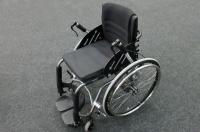Lever drive wheelchairs straight from the Faculty of Transport, Warsaw University of Technology
One might think that the biggest problem of people moving around in wheelchairs is the inability to walk. Standard wheelchairs, however, may lead to more injuries. Designers from the Warsaw University of Technology (WUT) are working on a lever drive wheelchair, which will – among other things - prevent its users from sustaining injuries to their hands. The project is developed at the Faculty of Transport, Department of Computer and Rail Systems in Transport. Krzysztof Fiok, Ph.D. (Eng) is its supervisor.
Making good solutions work
A lever drive manual wheelchair is thought to be an answer to disabled people’s problems. That kind of solution has already been applied worldwide, however, its popularity remains rather poor. Using lever drive wheelchairs contributes to disabled people’s rehabilitation as activating the lever drive requires a larger number of muscles to work.
“The levers are a key innovation here and although the concept of lever drive wheelchairs has been known around the world since the 1960s, frankly, there has been no spectacularly successful implementation”, says Krzysztof Fiok, Ph.D.(Eng) from the Faculty of Transport in an interview with the Bulletin of the Warsaw University of Technology. “To be honest, the 1970s were the golden age of lever drive wheelchairs in Germany but in Poland they were totally unknown and they soon fell into oblivion”.
Working on the project
The new solutions were tested using various measuring techniques to measure the fatigue of a person moving about in a wheelchair. For this purpose, the method of superficial electromyography was applied to help identify the scope of design approaches aimed at improving wheelchair users’ comfort and the effectiveness of work performed by them.
Taking into consideration the existing solutions that have already been applied, the wheelchair from the Warsaw University of Technology is quite an improvement. Research is conducted on a mechatronic simulator, which can also work as a training station for people wishing to use that kind of wheelchair.
New solutions
Lever drive wheelchairs are often said to belong to the recreational/sports wheelchair group. Although this solution has been known for a number of years, such wheelchairs need further development if they are to be used on an everyday basis. Its designers from the Warsaw University of Technology intend to achieve high efficiency and the best working conditions in terms of ergonomics.
“In relation to work efficiency and ergonomics, the advantages of lever drive wheelchairs are particularly noticeable on longer distances where lever work is much more effective”, Krzysztof Fiok, Ph.D. (Eng) emphasises. “This is due to the fact that the position of the whole body and the path followed by the moving wheelchair is much better when using its levers”.
The solution proposed by the designers from the Warsaw University of Technology offers the option of switching between two modes of driving. Covering longer distances will necessitate using the levers, whereas indoor driving will involve the use of the pushing rings rather than anything else. The wheelchair is to be user-friendly also for those with various levels of disability.
The project “Lever drive wheelchairs for the disabled” is implemented by the consortium of the Faculty of Transport at the Warsaw University of Technology and the company GTM-Mobil. Students and staff of the Faculty of Automotive and Construction Machinery Engineering are also involved in the project. The construction of the lever drive wheelchair forms part of a larger project entitled “Eco-mobility”. At some stage of working on the lever drive, wheelchair disabled people were consulted and asked to give feedback as to what should be improved.
Now this work is nearing its end – the wheelchair is to be ready by the end of August 2016. The model will be developed by GTM-Mobil, which means that more or less within a year WUT wheelchairs should be available on the market.
Monika Bukowska
Office for Promotion and Information
Based on:
http://www.eco-mobilnosc.pw.edu.pl/pl_wozek-dzwigniowy,52.html








